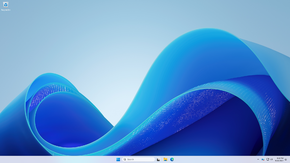Build list legend
Non-existent page
| Version of Microsoft Windows | |
 | |
| OS family | Windows 11 (NT 10.0) |
|---|---|
| Version | 24H2 |
| Semester | Germanium |
| Architecture | AMD64, ARM64 |
| Latest build | 10.0.26100.3775 |
| Release date | 2024-11-01 |
| Support end | 2034-10-10 |
| Client counterpart | |
| Windows 11 2024 Update | |
| Replaces | |
| Windows Server 2022 (LTSC) Windows Server, version 23H2 (AC) | |
Windows Server 2025 is the current long term servicing channel release of Windows Server, which was released on 1 November 2024.[1] The operating system was announced on 26 January 2024.[2]
The functional levels for Active Directory domains and forests have been updated to level 10 to accommodate for an architectural overhaul in the Extensible Storage Engine that extends the overall database paging size to 32,768 pages and incorporates the use of 64-bit long value IDs, along with the addition of new attributes towards the Active Directory schema.
Hotpatching, a feature that allows system updates to be applied on top of a live system without the need for reboots, has been extended to support all applicable Windows Server editions rather than being limited to select releases such as Datacenter: Azure Edition and Azure Stack HCI.
Build upgrades through the Windows Update service (via the Unified Update Platform) are now supported; this also includes upgrades instituted via the Windows Insider Program.
Virtual machines now support discrete device management, allowing the host machine to allocate graphics processing units to individual VMs for large workloads. GPU partitioning has been implemented into the operating system, allowing servers to reserve memory for one GPU across multiple virtual machines at once in a multi-GPU configuration.
Performance optimizations have been made to network-attached storage servers with NVMe 2.0 drives through the introduction of a TCP-based initiator. Native support for data compression in storage replicas and within the ReFS file system has been introduced, and thin disk provisioning support has been added to the Storage Spaces feature.
NTLM authentication requests can now be throttled over a set duration of time (via the Set-SmbServerConfiguration parameter -InvalidAuthenticationDelayTimeInMs) if a user sends a bad request. Server Message Block requests are now signed in all Windows releases by default in an effort to prevent man-in-the-middle attacks, and new group policies for minimum and maximum SMB versions have also been added.
A number of features have been gradually phased out as part of Windows Server 2025. The NTLM security protocol has been replaced by Kerberos to prevent further future pass-the-hash and SMBRelay attacks against existing user accounts, remote mailslots (a dated and simple IPC method that is both unreliable and insecure) have also been deprecated and disabled by default, as was the WebDAV Redirector service. Support for TLS versions 1.0 and 1.1 were dropped following the issuance of IETF RFC 8996, which deprecated both standards due to their usage of the insecure SHA-1 hashing algorithm,[3] and the Windows Server Update Services (WSUS) feature is no longer actively developed.
The VBScript scripting engine and the Windows Management Instrumentation command-line (WMIC) tool have been deprecated in favor of migrating pre-existing scripts to work with the PowerShell command-line interpreter. Similarly, the legacy Windows PowerShell v2.0 scripting engine (introduced as part of Windows 7) has been removed in an effort to further facilitate migrating scripts to work against the newer v5.0+ API.
The Internet Information Services 6.0 management console from Windows Server 2003 has also been fully phased out. Built-in mail server functionality via the SMTP Server role is no longer available as the optional Microsoft Exchange Server suite has largely superseded its previous purposes, and WordPad was removed in favor of having the customer opt for a fully-fledged word processing suite of their choice.
Build list legend
Development of Gallium fluently transitioned into Germanium around build 25941 and did not enter a stabilization phase usually associated with the creation of release branches.
rs_prerelease branch)[edit | edit source]ge_prerelease branch, see Germanium.ge_release branch)[edit | edit source]